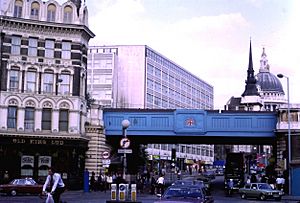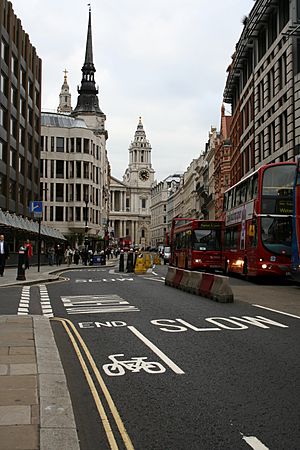Ludgate Hill facts for kids

Ludgate Hill is a famous hill in the City of London. It is close to where the old Ludgate once stood. This gate was a main entrance to the City. It was taken down in 1760, along with its attached prison.
Today, St Paul's Cathedral stands on Ludgate Hill. People traditionally believe a Roman temple to the goddess Diana was there before. Ludgate Hill is one of London's three oldest hills. The others are Tower Hill and Cornhill. The highest point of the hill is about 17.6 metres (58 ft) above sea level.
Ludgate Hill is also the name of a street. This street runs between St Paul's Churchyard and Ludgate Circus. From Ludgate Circus, it becomes Fleet Street. It used to be a much narrower street called Ludgate Street.
Contents
What is Ludgate Hill Like?
Many small paths on Ludgate Hill were removed in the 1860s. This was to build the Ludgate Hill railway station. The station closed in 1923. Its railway bridge was taken down in 1990. This made way for the City Thameslink railway station, which is now underground.
You can find a blue plaque near the bottom of the hill. It says that the first London daily newspaper, The Daily Courant, was published nearby in 1702.
About halfway up Ludgate Hill is the church of St Martin, Ludgate. This church was once physically connected to the old Ludgate gate.
Paternoster Square is also on the hill. It is just north of St. Paul's Cathedral. Since 2004, it has been home to the London Stock Exchange.
Where Did the Name Come From?
The name Ludgate likely comes from an old English term. This term was "hlid-geat" (pronounced "lid-gat"). It meant "swing gate" or "postern" (a small, private gate). You can still find this old word in some place names in England.
A very old book from 1136, Historia Regum Britanniae, mentions Ludgate. This book tells a story that the name comes from a mythical Welsh king named Lud son of Heli. The story says King Lud also gave his name to London. Another old book, The Cronycullys of Englonde, says he built a "fayre gate" called Lud Gate in 66 BC. However, it is more likely that the Romans built the first gate. The name might simply be a variation of "Fleodgaet," meaning "Fleet-gate," after the nearby River Fleet.
Stories and Famous Places
Many interesting stories are connected to Ludgate Hill.
The Bell Savage Inn
At the bottom of Ludgate Hill, you'll find Limeburner Lane. This area was once home to the Bell Savage Inn. This old inn was first mentioned in 1452. Plays were often performed there. Some people say its name came from a woman named Isabella Savage. Others believe it meant "La belle Sauvage," which is French for "the beautiful wild woman."
A famous clown named Richard Tarlton used to perform at the inn. The Bell Savage Inn is mentioned in famous books. These include Tom Brown's School Days and The Pickwick Papers. In 1684, a rhinoceros from the East Indies was even put on show there! The inn was taken down in 1873.
The London Coffee House
From 1731, the "London Coffee House" was next to St. Martin's, Ludgate. Famous people like Joseph Priestley and Benjamin Franklin visited it. If juries at the Old Bailey court could not agree on a decision, they would stay here overnight. The London Coffee House closed in 1867. Today, a pub called "Ye Olde London" is in its place.
Blackfriars Theatre
The Blackfriars, a group of monks, came to London in 1221. In 1278, they moved to an area south of Ludgate. There, they built a large friary (monastery). They even took down part of the old Roman wall to build a new wall for their friary.
Later, in 1596, James Burbage bought part of this property. He was the manager of Shakespeare's acting company. This area was already being used as a theatre. However, it wasn't until 1609 that Shakespeare's company, then called The King's Men, could perform at the Blackfriars Theatre. In 1613, Shakespeare himself bought a gate-house nearby.



